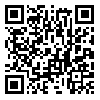Volume 8, Issue 2 (Summer 2022)
JMIS 2022, 8(2): 140-151 |
Back to browse issues page
Download citation:
BibTeX | RIS | EndNote | Medlars | ProCite | Reference Manager | RefWorks
Send citation to:



BibTeX | RIS | EndNote | Medlars | ProCite | Reference Manager | RefWorks
Send citation to:
Maserat E, Alizadeh M, Mohammadazdeh Z, Torkmania A, Torab-Miandoab A. Effect of Education on the Adoption of Patient Portals by Health-related Non-Governmental Organizations Using the Technology Acceptance Model. JMIS 2022; 8 (2) :140-151
URL: http://jmis.hums.ac.ir/article-1-364-en.html
URL: http://jmis.hums.ac.ir/article-1-364-en.html
Department of Health Information Technology, School of Management & Medical informatics, Tabriz University of Medical Sciences, Tabriz, Iran.
Abstract: (3419 Views)
Objective Organizational portals play a key role in increasing the efficiency of Non-Governmental Organizations (NGOs). Considering that education can affect the perception of their usefulness, acceptance and adoption, this study aims to assess the effect of education on the adoption of patient portals by health-related NGOs using the technology acceptance model.
Methods The is an applied study. The statistical population consists of all employees of health-related NGOs in Tabriz, Iran in 2019. Of these, 32 were selected by a random sampling method. The data collection tool was a questionnaire assessing factors affecting the adoption of technology with acceptable validity and reliability. Data analysis was performed using paired t-test, Pearson correlation test, and linear regression in SPSS v. 22 software.
Results The mean age of participants was 46 years; 59.38% had moderate computer skills and familiarity with information technology, formation technology, formation technology, formation technology, and 68.75% were not familiar with the portals. There was a significant difference in the adoption of portal technology before and after the education (P=0.05).
Conclusion The educational intervention has a positive impact on improving the patient portal adoption in health-related NGOs. Therefore, the planners need to consider the effect of this method in their policies.
Methods The is an applied study. The statistical population consists of all employees of health-related NGOs in Tabriz, Iran in 2019. Of these, 32 were selected by a random sampling method. The data collection tool was a questionnaire assessing factors affecting the adoption of technology with acceptable validity and reliability. Data analysis was performed using paired t-test, Pearson correlation test, and linear regression in SPSS v. 22 software.
Results The mean age of participants was 46 years; 59.38% had moderate computer skills and familiarity with information technology, formation technology, formation technology, formation technology, and 68.75% were not familiar with the portals. There was a significant difference in the adoption of portal technology before and after the education (P=0.05).
Conclusion The educational intervention has a positive impact on improving the patient portal adoption in health-related NGOs. Therefore, the planners need to consider the effect of this method in their policies.
Type of Study: Research |
Subject:
Special
Received: 2021/10/26 | Accepted: 2022/04/9 | Published: 2022/07/1
Received: 2021/10/26 | Accepted: 2022/04/9 | Published: 2022/07/1
Send email to the article author
| Rights and permissions | |
 |
This work is licensed under a Creative Commons Attribution-NonCommercial 4.0 International License. |








 hums.ac.ir
hums.ac.ir